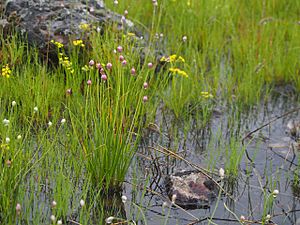Douglas onion facts for kids
Quick facts for kids Douglas onion |
|
|---|---|
 |
|
| Allium douglasii in Lincoln County, Washington, US | |
| Scientific classification | |
| Synonyms | |
|
Allium hendersonii B.L.Rob. & Seaton |
The Douglas onion (scientific name: Allium douglasii) is a type of plant that grows naturally in parts of the United States. You can find it in northeastern Oregon, eastern Washington, and northern Idaho. This plant likes to grow in thin layers of soil, often found on hillsides, at heights between about 1,300 and 4,300 feet (400 to 1,300 meters) above sea level.
Contents
What Does the Douglas Onion Look Like?
The Douglas onion grows from a special underground part called a bulb. These bulbs are shaped like eggs and can be up to about 1.2 inches (3 centimeters) long.
From the bulb, a smooth, round stem grows straight up. This stem is called a scape and can reach up to 16 inches (40 centimeters) tall. At the top of this stem, you'll find the flowers.
Douglas Onion Flowers
The flowers of the Douglas onion are quite small, usually about 0.4 inches (10 millimeters) wide. They have pretty pink or purple parts that look like petals, called tepals. Each tepal often has a green stripe down its middle.
Inside the flowers, there are blue anthers, which are the parts that hold the pollen. The pollen itself is usually white or a light gray color.
Where Does the Douglas Onion Grow?
This plant is native to the Pacific Northwest region of the United States. It thrives in specific areas of Oregon, Washington, and Idaho. It prefers places where the soil isn't very deep, which means it can often be found in rocky or shallow ground. The plant is well-adapted to the climate and conditions of these regions.
See also
 In Spanish: Allium douglasii para niños
In Spanish: Allium douglasii para niños

